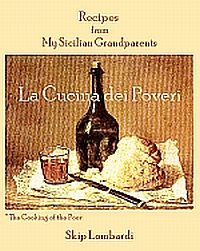Adventures of an Italian Food Lover
August 30th, 2007
Adventures of an Italian Food Lover
With Recipes from 254 of my Best Friends
Faith Willinger
Clarkson Potter (July 10, 2007); 256 pages; $32.50
We wouldn’t mind starting our days the way Faith Willinger does—coffee at the Santo Spirito market in Florence before a stroll over to the open air produce section to chat with friends about ricotta salata or le primizie, the earliest of spring vegetables, or simply to inquire, “what’s good today?”
The conversation continues in Adventures of an Italian Food Lover, Ms. Willinger’s assemblage of 107 recipes “from 252 of her best friends.” Much of the book is devoted to brief profiles of an eclectic and entertaining group of restaurateurs; caffè owners; and artisans producing pasta, cheese, wine, grappa, vinegar, and gelato. These characters, including, the inventor of pescaturismo, charter fishing vacations in Italy, shine just as brightly as her more notable companions: Arrigo Cipriani, owner of Harry’s Bar; Dario Cecchini, the flamboyant Tuscan butcher known for quoting Dante to his customers; and Fabio Picchi, culinary rock-star chef and owner of Cibreo in Florence.
But famous or not, Ms. Willinger’s friends are no slouches. Virtually every one of them has chosen food as a vocation, and all have secured a place in Ms. Willinger’s heart. Thoughtfully, she includes the names of their businesses, hours of operation, addresses, telephone numbers, e-mail and web sites alongside the profiles. The book is as much memoir as Italian food compendium. But as cooks and travelers, we wish that the wealth of information within these pages were organized in a more conventional and accessible manner—with a complete table of contents and an index listing the personalities and their establishments.
This album of gastronomic personalities, is divided into three main sections: North & Central Italy, Tuscany, and Southern Italy & the Islands. Within these broad divisions, recipes are presented in the traditional manner of antipasti, primi, secondi, and dolci.
We found it slightly disconcerting that the recipes are titled and indexed in English, and only in English. After years of seeing Italian cookbooks on coffee tables and Molto Mario e amici on the Food Network, even kitchen novices are familiar with the names of dozens of Italian dishes. We actually had some trouble finding recipes we were sure would be in the cookbook. It took us a while to locate Schiacciata, Tuscan bread with grapes, which appears undercover as ‘Etruscan Grape Tart.’
Most of the recipes are uncomplicated and easily approachable by a home cook. With most, their very simplicity transmits the message that using the finest ingredients makes a difference. A quickly prepared dish from the Amalfi coast, Pasta with Walnuts and Anchovies, needs but a few spoonfuls of extra virgin olive oil to go from pleasant to ethereal. Little more than lentils and aromatic vegetables, a basic soup is similarly elevated by a finish with flavorful olive oil. A Sicilian recipe for risotto with broccoli and almonds goes from plebeian to aristocratic with the use of vialone nano rice rather than arborio.
We’re a little skeptical about a couple of recipes Ms. Willinger’s friends share with her. For example, a recipe for Mussels with Yogurt Sauce from Sardinia sounds odd, because virtually no Mediterranean culinary tradition (except French) combines shellfish with dairy products. Perhaps, though, this represents another aspect of Italy today: la cucina nuova, the new cuisine.
Of course, writing about friends requires dining with friends. That’s what much of this book is about—the pleasure of communal dining. Ms. Willinger talks with fondness about her sister, Suzanne, with whom she goes out for coffee every day. (Suzanne Heller’s watercolors—portraits, landscapes and charming renditions of vegetables—grace her sister’s book.) A recipe for Arista di Maiale, Roasted Loin of Pork is included as a tribute to her Italian husband, because it used to be his job to chop the herbs that his mother used to stuff a loin of pork. Though Ms. Willinger’s own son is grown and no longer lives at home, a recipe for the brownies made for his birthdays gets its due.
In these pages, food is always in a social context. It’s always inclusive and largely caslinga, home-cooking, far from la menu turistica. In America, it’s increasingly difficult to pull people together for a meal (We’re working late, have soccer practice, homework, second jobs…Or we’re on diets that exclude carbohydrates or fat or meat or dairy…) It seems that too often the American friends to whom you’d like to extend an invitation are too busy, too tired, overweight or allergic to something.
Meanwhile, somewhere in Florence, Faith Willinger not only waxes rhapsodic about the joys of sitting down to share food with friends, she does it.
Disclosure: Clarkson Potter sent us this book for our review.



